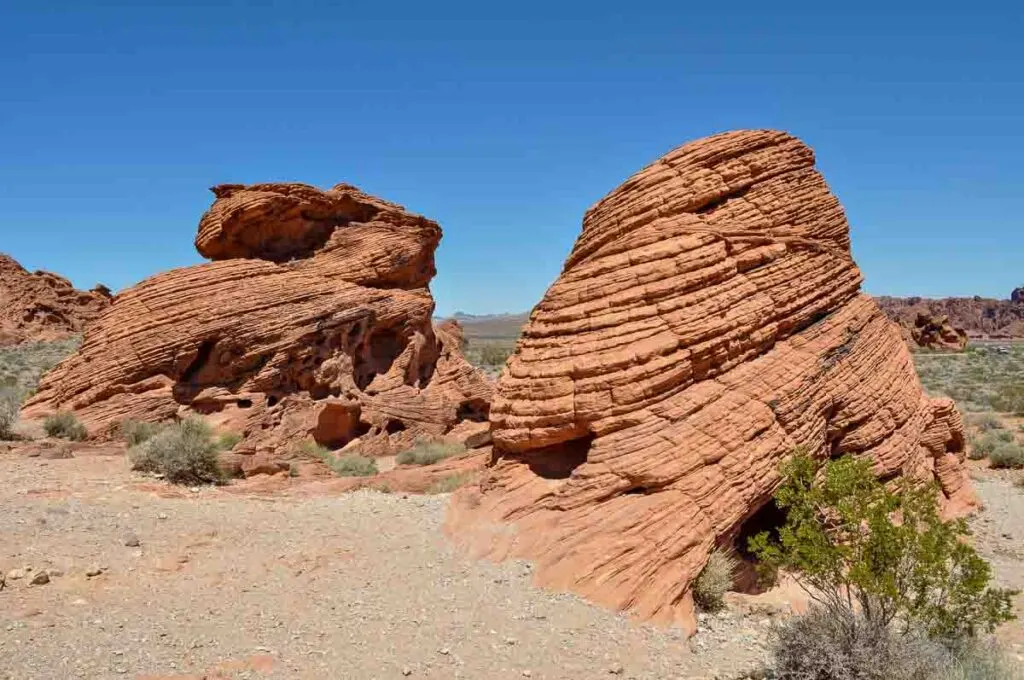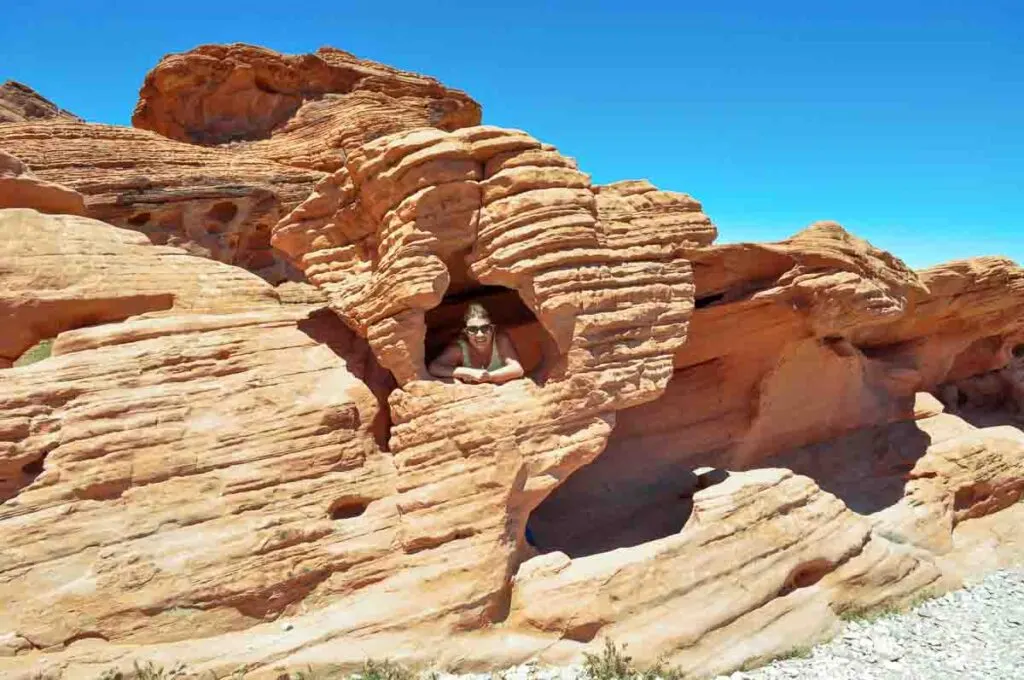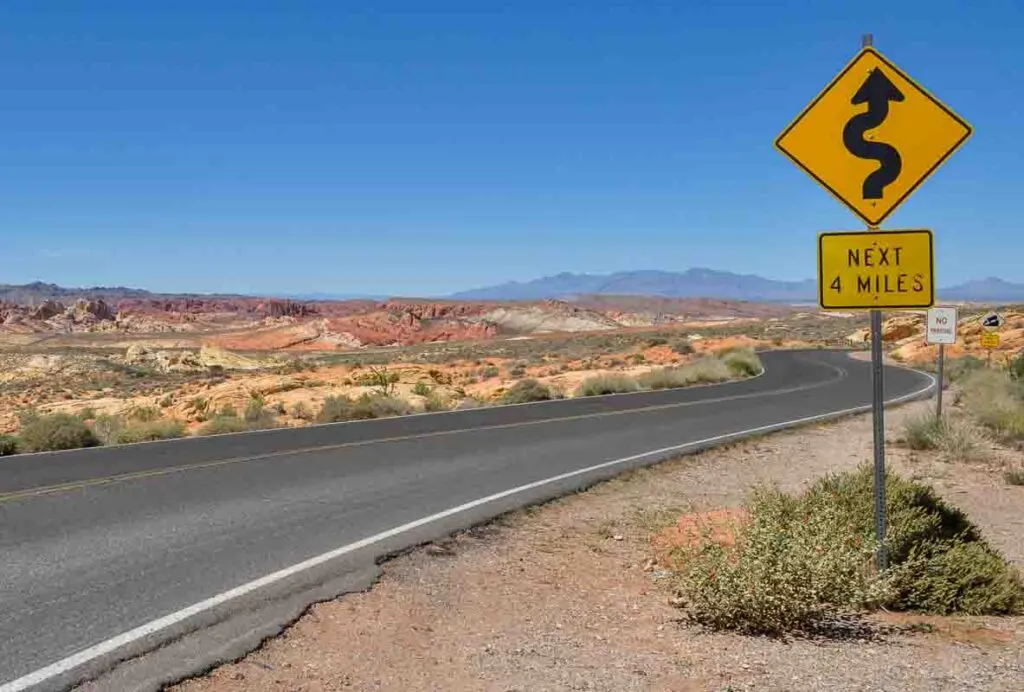A tour of The Valley of Fire State Park, set in the wild beauty of the Mojave Desert, makes a fabulous day trip from Las Vegas and offers a dramatic and refreshing contrast to the buzz of the city.
When you’re feeling burned out by all the craziness of Las Vegas, and the neon lights of The Strip are indelibly etched into your mind’s eye, it’s time to strike out and see a different side of Nevada.

The Valley of Fire Scenic Byway and State Park has a varied and fascinating landscape of rock arches, domes, red rocks and colourful vistas. The vibrant layered sandstones are shaped and contoured by wind and water, and the desert sun highlights panoramic vistas ablaze with colour.
The stunning landscapes, breathtaking red sandstone formations and panoramic views make the Valley of Fire one of the best outdoor things to do near Las Vegas.
A day trip to the Valley of Fire from Las Vegas
Contents
Whether you take scenic drives through the park, take on the hiking trails or take a tour of Valley of Fire State Park., it makes a fabulous day trip from Las Vegas. You can also extend your stay by spending a night in one of the campsites.
If you’re visiting the United States and would like to take a day trip from Las Vegas to the Valley of Fire, read on to learn about this historic state park’s fabulous landmarks and viewpoints. I’ll also share some tips to help you plan the perfect day out.
Where is the Valley of Fire?
The Valley of Fire State Park is about 50 miles northeast of Las Vegas in the Mojave Desert, Nevada, and lies around 16 miles south of Overton, Nevada. It’s also near to Lake Mead recreation area.
The Valley of Fire reminded me a lot of the lanscape in Sedona, without the vortexes!

History of the Park
When you visit the park, you can see ancient petroglyphs (rock art) and other historic artefacts. These were left behind by indigenous populations including the Basketmakers, who lived in the area 2500 years ago, and the Ancestral Puebloans, also known as the Anasazi, who lived in the area between 300 BC and 1150 AD and farmed the nearby Moapa Valley.
The area was designated as a Nevada State Park in 1935. It was Nevada’s first state park, and this public recreation and nature preservation area now covers around 46,000 acres, making it the largest state park in Nevada. The park’s name apparently came from an AAA official driving through the area at sunset, who said the glow of the red Aztec Sandstone made the valley appear on fire.

Weather in the Valley of Fire State Park
The Mojave Desert has a dry and warm climate. The mild winters have daytime temperatures averaging 12-14°C and occasional rain showers. Summer daytime temperatures are usually around 38-46°C and can reach 49°C, with occasional heavy showers and thunderstorms. We visited in April and it was very hot.
Best Things to See in the Valley of Fire
If you’re planning a trip to see the Valley of Fire, here are some of the top viewpoints, trails and landmarks to help you plan your day. You can see a lot of the sights from close to the road so if you’re not big on hiking then you won’t miss out.
Fire Cave
The Windstone Arch made Fire Cave a popular photography spot for many years, but unfortunately, the archway collapsed in May 2021. However, the short hike to Fire Cave is still worthwhile, as you can enjoy the impressive views along the trail and take a peek inside Fire Cave. It will probably be a little quieter now that the famous arch is no more. The cave is actually quite tiny.
Rainbow Vista

If you were awe-struck by the striking red sandstone landscape as you drove into the Valley of Fire, prepare to be blown away by Rainbow Vista. This view blew me away. The red rock canyons, towers, domes and ridges you see here were hewn out of sand dunes deposited 150 million years ago when dinosaurs roamed the earth.
The views at the trailhead are breathtaking, but they get even better as you hike along the mile-long Rainbow Vista trail. Allow time to soak in the great views and take plenty of photos when you reach the Fire Canyon overlook at the end of the trail.
Tip: There’s a restroom at the Rainbow Vista parking lot.
Mouse’s Tank
Mouse’s Tank is one of the most popular hikes in the Valley of Fire, as it has lots of opportunities for off-trail scrambling and plenty of interesting petroglyphs, including geometric designs, handprints and people.
The natural water tanks here are named after an 1890s Southern Paiute Indian named Little Mouse, who used the tanks as a hideout after being accused of killing two prospectors.
Mouse’s Tank is also the site of the hilled road that you’ve probably seen on the gram also known as White Domes Road. It forks northwards close to the Visitor Centre. Come early in the morning to get ahead of the crowds and climb higher on the rocks for a different angle.
Pink Canyon

Valley of Fire State Park is well known for its vibrant red rock formations, but the Pink Canyon is one of the lesser-known parts of the park. Here, the canyon is formed out of rock in soft shades of pastel pink, yellow and orange – very gram-worthy!
Pastel Canyon is also one of the quieter parts of the park, as the trail isn’t on the map, and there are no signs to point it out. That makes it one of the best places to escape the crowds and enjoy some peace in this heavenly pastel-hued spot. The colours look even better in the morning and late afternoon when the sun is at a lower angle.
Elephant Rock
This has to be one of the most unusual red rock formations in Valley of Fire State Park. Somehow, the rock has eroded into a natural arch that looks just like an elephant’s head and trunk. If you step back a little further, you can also make out the rest of the elephant.
Elephant Rock is right on the roadside, but there’s limited parking on Valley of Fire Road. It’s better to park in the nearby car park and walk up to the rock. And it goes without saying that there’s no climbing allowed on this fragile natural arch.
The Beehives

Be sure to check out the Beehives if you’re driving through the park – you can spot these unusual red sandstone formations from the road. If you enter the park from the west entrance they’ll be the first thing you see.
The grooved lines around the red rock of the Beehives were formed by layers of silt deposited over time. The different angles of the layers show the angle at which the wind or water was moving when the silt was deposited.
These pictures don’t show the true scale of the beehives. The one on the right is about 3 people high.
Atlatl Rock and Petroglyphs

One of the best stops on our Valley of Fire tour was Atlatl Rock on the petroglyph canyon trail. This is named after the atlatl which is a dart thrower was used by ancient tribes before the bow and arrow. You can spot these weapons depicted in the petroglyphs on Atlatl Rock.
We climbed a metal staircase attached to Atlatl Rock to view the ancient petroglyphs. There are many areas throughout the state park where petroglyphs can be seen, and we spotted more on various canyon trails.
Fire Wave

It’s easy to see why the Fire Wave trail is one of the most popular hiking trails in Valley of Fire State Park. The fabulous colour patterns in the rock formations here are breathtaking, with red, orange and ochre sandstone stripes.
This trail is only 1.5 miles long, but with such incredible views, you’ll want to take lots of photos, so give yourself at least an hour or maybe a little longer to complete the hike. It also gets pretty busy here, so head out early to avoid the crowds.
Arch Rock
Arch Rock was formed by wind and water erosion over many thousands of years. The softer rock was gradually worn away, leaving behind the beautiful natural arch you can see today.
The space under the arch will continue to grow until, eventually, the arch becomes too weak and collapses, so no climbing is allowed on Arch Rock. But, for now, it’s a great spot for taking photos and one of the must-see locations in Valley of Fire State Park.
Balancing Rock

Just a short hike from the visitor centre is one of the most famous Valley of Fire formations – Balancing Rock aka Balanced Rock.
The tower is about 20 feet tall, and its ‘head’ appears to be balanced precariously on top of the main body of the formation. This strange tilted appearance was caused by geologic faulting and erosion by wind and water.
Balancing Rock is fragile, so please don’t attempt to climb it.
White Domes
The White Domes trail is a short loop at the end of Mouse’s Tank Road that takes you down through small slot canyons and past colourful sandstone formations. At the bottom of the trail, you can also see the remains of the set for the 1966 film “The Professionals”.
This is one of the easiest and prettiest trails in the park, making it very popular – go early in the morning if you want to avoid the crowds.
Valley of Fire was also one of three filming locations for “Total Recall”
Seven Sisters
If you can only stay for an hour or two at the Valley of Fire State Park, Seven Sisters is one of the must-see locations.
This iconic group of seven towering red boulders stands tall above the sandy desert. Once encased in sandstone, the Seven Sisters were revealed by erosion, and this same destructive force will eventually destroy the towers themselves many hundreds of years into the future. There are picnic facilities nearby
Fire Canyon and Silica Dome Viewpoint
The Fire Canyon and Silica Dome Lookout lies in the centre of the Valley of Fire. This high point offers fantastic views of two of the park’s best-known geological features: Silica Dome and Fire Canyon.
The rock formations you can see around the Valley of Fire are hewn from almost pure silica. Silica Dome is one of the best examples in the park, and the stone ranges from white at the top to red at the base of the dome, where the iron content of the rock gives it a rust-like colour.
Fire Canyon is covered by a thick layer of fiery red sand, and you can see nearly every type of rock formation here, from pinnacles and beehives to arches and balancing rocks.
Petrified Logs
Petrified wood is a fossil of wood which has had all of its organic matter replaced by minerals. The Petrified Logs are several colourful tree trunks that were washed into the Valley of Fire by flood waters around 150 million years ago and became buried by silt, sand, and sea deposits.
These colourful logs are now safely fenced off next to a gravel road on the southwest side of the park.
Valley of Fire – The Cabins

These historic stone cabins were built by the Civilian Conservation Corps (CCC) in the early years of this Nevada state park. The CCC was a voluntary work relief programme that provided manual labour jobs for unemployed and unmarried men during the Great Depression.
Nowadays, the cabins are a picnic area, and we stopped off for lunch there during our visit. We saw some ground squirrels skorting around the picnic tables – these cute little creatures certainly know where to go for easy pickings!
Desert bighorn sheep roam throughout Valley of Fire and if you’re lucky you might spot some during your visit. They’re often seen on the red rocks up behind the visitor centre.

Best Hikes in the Valley of Fire
There are many excellent hikes through the Valley of Fire, with difficulties ranging from beginner to expert level. The Valley of Fire Visitor Center will be able to help with suggestions for hikes to suit you, but here are some of the most popular hikes, all suitable for beginners:
Atlatl Rock Hike
This easy hike is less than a mile long and will allow you to see some of the best prehistoric petroglyphs in the Valley of Fire Park.
White Domes Trail

The White Domes trail is a 1.1-mile round trip that takes you through some of the park’s most stunning vistas. As well as the white sandstone rocks known as the White Domes, you’ll also see a small slot canyon and caves. This connects with the Seven Wonders loop and can be combined.
Mouse’s Tank Hike
The popular Mouse’s Tank trail will take you to the natural rock basin where the Southern Paiute Indian named Little Mouse once hid. This trail is just under a mile round trip, and you can spot prehistoric petroglyphs along the way.

How to visit the Valley of Fire from Las Vegas
The Valley of Fire is near Overton, NV, and around 53 miles northeast of Las Vegas, so it’s ideal for a day trip from Las Vegas.
Self-Drive Directions
If you have access to a car, it’s pretty easy to get from Las Vegas to the Valley of Fire State Park. Take the US-95 N slip road to the I-15 N, then stay on the I-15N for around 33 miles until you reach exit 75 for the Valley of Fire Highway.
Merge onto the Valley of Fire Highway and stay on that road for 18 miles until you reach the park. Your road trip should take around an hour.
Two main roads run through the Valley of Fire Park. The main paved scenic road, The Valley of Fire Highway NV 169, runs north and south right through the park. The road is also known as Mouse Tank Road or White Domes Road.
The 10.5 mile section of the road that runs between the park’s east entrance and west entrance was designated as a Nevada Scenic Byway in 1995.
Valley of Fire state park guided tours
If time is tight or you don’t have access to a car, a guided tour is the best way to visit Valley of Fire State Park.

Valley of Fire State Park Tour
This 7-hour small group tour begins with pickup from your Las Vegas hotel from 7am. You’ll stop off briefly in the California Mojave Desert and the Moapa Indian Reservation before spending the day exploring the park with your expert guide. Check rates and availability.
Valley of Fire Sunset Tour
If an early start doesn’t appeal, this sunset tour could be your perfect Valley of Fire tour. You’ll be collected from your hotel on the Las Vegas Strip and will spend three hours in the Valley of Fire, accompanied by your tour guide.
Watching the sunset over the park from Rainbow Vista is sure to be an unforgettable experience! Check rates and availability here.
Tips for visiting
Here are some tips to help make your trip to the Valley of Fire state park run smoothly.
Please remember that state and federal laws protect the area, its resources, and all historical artefacts. Removing, disturbing, or damaging any rocks, plants, fossils, artefacts or historic structures is forbidden.
Rock climbing is allowed in some parts of Valley of Fire but NOT on Arch Rock, Elephant Rock, and Atlatl Rock.
Historic Site Etiquette
The historic sites and petroglyphs are fragile and can never be replaced if they are damaged. The basic rules to remember are:
- Never touch the petroglyphs – altering, defacing, or damaging petroglyphs is against the law.
- Photography and sketching are allowed but don’t add anything to the petroglyphs.
- Stay on existing trails, and don’t trample over vegetation.
- If you take your dog with you, remember to clean up after them.
- If you see any historic artefacts, leave them where you find them.
Entrance fees
The current (2024) entrance fees to the Valley of Fire are:
- Day Entrance Fee (NV Vehicle): $10.00
- Day Entrance Fee (Non-NV Vehicle): $15.00
- Day Entrance Fee (Bike): $2.00
- Camping (NV Vehicle): $20.00 per vehicle per night
- Camping (Non-NV Vehicle): $25.00 per vehicle per night
- Utility Hook Up: $10.00
Opening times

Valley of Fire State Park is open to visitors seven days a week, 365 days a year.
The park opens from sunrise to sunset, and the office hours are 9am to 4pm, Monday to Friday (except state holidays).
If you’re staying overnight at the Valley of Fire, you must be in your campground or group camping area by sunset. Activity is limited to campsites and group-use campsites after sunset.
Visitor Centre
When you arrive at the park, it’s a good idea to make the Valley of Fire State Park Visitor Center one of your first ports of call.
The visitor centre is open daily from 9am to 4pm and contains fascinating exhibits about the area’s history, wildlife and geology. You can watch a short film about the park. You’ll find advice on hiking trails and you can also buy postcards, books and souvenirs here.
Dogs
Your four-legged friend is welcome to accompany you to the Valley of Fire, but they must stay on a lead no longer than six feet. Pets are not allowed inside the park’s Visitor Centre.
Drones
Drones and remote-controlled aircraft are not allowed within Valley of Fire State Park.
Camping, RV and picnic sites
Camping is only allowed in designated campground sites, which are available by reservation. There is a limit of 14 days camping in any 30 days.
Atlatl Rock campground and Arch Rock campground have a combined total of 72 units, and the sites are equipped with showers, restrooms, grills, shaded tables and water. There are also three group campsites, each with a maximum group size of 45.
The park also has RV camping sites with power and water hookups. Availability for RV sites is on a first-come, first-served basis. There’s also a dump station.
Picnic sites are located at Seven Sisters, Atlatl Rock and the Cabins. There are also sites near the White Domes and the Mouse’s Tank Trailhead.
Paid WiFi is available within Valley of Fire State Park, but mobile phone coverage is spotty. It’s a good idea to download maps before you visit.
Fires
Fires are only permitted in designated fire grills and fireplaces.
What to take
Remember to take a hat, protective clothing and sunscreen when visiting Valley of Fire. Make sure you have plenty of water and snacks with you, as there’s no water available in the park.
The weather can be oppressively hot in the summer, with daytime temperatures usually above 38°C. It’s better to visit the Valley of Fire when the weather is milder, but if you decide to visit in summer, wear shoes with rubber soles to protect your feet. We visited at the end of April and it was hot.
Valley of Fire Map
You might find this PDF map showing the Valley of Fire highlights, hiking trails, parking, camping and picnic areas.
If you only have a few hours but want to get out in nature then Red Rock Canyon Conservation Area is a lot closer to Las Vegas at just 16.2 miles away via US-95 N and NV-613.
I hope you’ve found this guide to visiting Valley of Fire State Park useful. If you love national parks you might also like this guide to visiting the Grand Canyon West Rim and how to visit Hoover Dam from Las Vegas.
Valley of Fire State Park FAQ

If you’d like more information about visiting the Valley of Fire Park, here are answers to some of the most frequently asked questions.
Is Valley of Fire a National Park?
Valley of Fire is Nevada’s oldest state park, but it isn’t a National Park. The only National Park in the state of Nevada is Great Basin National Park in the Snake Mountain Range, which is also an International Dark Sky Park.
When is the best time to visit Valley of Fire?
Summer in Nevada gets very hot, so it’s better to visit Valley of Fire State Park in the winter or spring.
Overcast days will be more comfortable and give better light for your photos. You’ll also find the temperatures are cooler in the early morning or late afternoon. Remember that you must leave the park or be at your campsite by sunset.
How long do you need at Valley of Fire State Park?
You should plan on spending at least 3 hours at the park, which will give you enough time to drive through the park and hike one or two of the shorter trails.
The Valley of Fire has enough to keep you occupied for a full day. If you have more time to spend at Valley of Fire, you can visit more of the spectacular locations in the park or go on a longer hike.

Suzanne Jones is a full-time travel blogger and writer at The Travelbunny which she started in 2011 during her time as a professional travel planner. Suzanne enjoys exploring new destinations, culinary encounters and the outdoors. When not travelling or writing about her adventures you’ll most likely find her, camera in hand, enjoying coastal walks in Sussex.
Suzanne also runs Hello Sussex a website which showcases the best of East & West Sussex. Read more about Suzanne.


The Travelbunny Summer Update | The Travelbunny
Sunday 12th of July 2015
[…] saw me finish up my Las Vegas posts with a visit to The Valley of Fire. It’s a fantastic way to get beyond Vegas and explore some of the Nevada desert. Did you […]
Suzanne Jones
Wednesday 8th of July 2015
I hope they have a great visit to Vegas
Emily Ray
Sunday 28th of June 2015
So gorgeous! My friend and I are going to Vegas in November, and we have a spare day to plan. I'd love to go here, it just looks so out of this world! x
Suzanne Jones
Sunday 28th of June 2015
It's a fab trip and really good to see a different side of Vegas. Enjoy!
Marc Jasin
Thursday 11th of June 2015
Those images are impressive and I would love to go there. Last two trips to Vegas I missed the Valley of fire but I am planing on revisiting this fall so I can enjoy it. Again great pictures Suzanne.
Suzanne Jones
Thursday 11th of June 2015
It's really easy to visit The Valley of Fire from Vegas and perfect for a day-trip from the city. Hope you get there later this year :)
Johanna Bradley
Monday 18th of May 2015
You can keep Vegas, Suze- I'll just have this one! What a stunner! I love it :)
Suzanne Jones
Monday 18th of May 2015
It was so quiet out there too Jo - such a contrast to the city :)